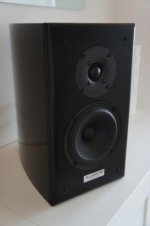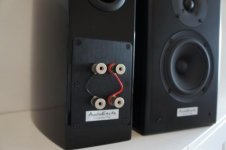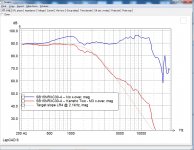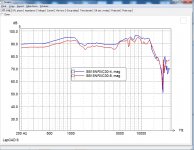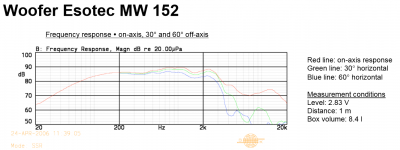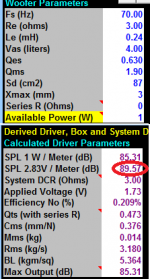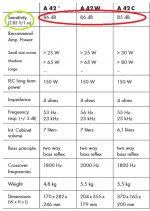Hi Everyone,
I've published an new loudspeaker design, the "Kensho Two – M3"
It's a great sounding low distorting low priced 2-way stand-mount speaker.
For further details see:
Kensho Two - M3
Regards
/Göran
I've published an new loudspeaker design, the "Kensho Two – M3"
It's a great sounding low distorting low priced 2-way stand-mount speaker.
For further details see:
Kensho Two - M3
Regards
/Göran
Attachments
Nice project. Those units are a little harder to voice right for these require extra correction network, which you have, to be able to cross over where you want it. I don't see a typical baffle step loss of spl.
Nice project. Those units are a little harder to voice right for these require extra correction network, which you have, to be able to cross over where you want it. I don't see a typical baffle step loss of spl.
Hi Lojzek,
Thank you!
The SB15NRXC30-4 is a very sensitive driver. If you look at the attached picture you can see the frequency response of it on the actual Dayton loudspeaker enclosure baffle.
Measurement conditions:
on-axis, 130mm below tweeter-axis @ 1m
Blue plot = SB15NRXC30-4 without x-over
Red plot = SB15NRXC30-4 with Kensho Two - M3 x-over
As you can see in the picture, the SB15NRXC30-4 needs some special attention in order to handle the baffle step, hence the response shaping (RLC) circuit in the Kensho Two - M3 x-over.
This driver also have an extended frequency response up to almost 15kHz, that also has to be handled properly in the x-over.
Regards
/Göran
Attachments
I was simmulating the same units and typically I get SPL at about 85dB with finished crossover (my kind of filter).
I was simmulating the same units and typically I get SPL at about 85dB with finished crossover (my kind of filter).
Hi,
Without knowing the details of your cross-over, I would expect that from the 8 ohm versions, not the 4 ohm version I used in my design.
Here's a comparison between the two on another test baffle.
Regards
/Göran
Attachments
I did the simulation of the 4 ohm bassmid version. If you observe manufacturer SPL value ( TS parameters) being 91dB, minus say 5dB to account for baffle step, you'd end up with 86dB. Your TS parameters suggests SPL of 90 dB, so it would be about 85 dB. My filter doesn't matter much at all in that respect. It's not clear to me how in open space the SPL at 200 Hz would still be that high, according to your design, about 89 dB. Or, am I misunderstanding something?
I did the simulation of the 4 ohm bassmid version. If you observe manufacturer SPL value ( TS parameters) being 91dB, minus say 5dB to account for baffle step, you'd end up with 86dB. Your TS parameters suggests SPL of 90 dB, so it would be about 85 dB. My filter doesn't matter much at all in that respect. It's not clear to me how in open space the SPL at 200 Hz would still be that high, according to your design, about 89 dB. Or, am I misunderstanding something?
Hi,
Did you do your simulation on real measurements on a loudspeaker baffle or the Manufacturers spec sheet infinite test baffle setup?
With the respect to SBAcoustics being one of the better ones in giving relatively accurate information in their specifications compared to other companies, in my opinion it's not that useful to do simulations based on spec sheets other than for fun.
I always do my simulations based on real measurements on the actual baffle the are intended to be used in and what you see in my examples is how they measure, nothing added or subtracted. 🙂
My previous measurement examples in this thread is the anechoic frequency response at 1m, 130mm above mid-woofer axis (~7deg vertically) and they are valid down to ~275Hz in my room measurement setup.
Regards
/Göran
Göran, of course I base my sims on manufacturer graphs. Where would I get better data?
But you're missing my point. When you simulate 89 dB in an 11 litre vented box tuned the way you did with an input voltage of 2,83V, that's a realistic value in half space (inifinite baffle)! How can you measure 89 dB with XO filter in open space with baffle step loss already acounted for, the same as 2 pi prediction?
SBA bassmid is a really solid piece of technology with really low Fs and we know that high sensitivity, small piston area and good bass performance doesn't go hand in hand.
But you're missing my point. When you simulate 89 dB in an 11 litre vented box tuned the way you did with an input voltage of 2,83V, that's a realistic value in half space (inifinite baffle)! How can you measure 89 dB with XO filter in open space with baffle step loss already acounted for, the same as 2 pi prediction?
SBA bassmid is a really solid piece of technology with really low Fs and we know that high sensitivity, small piston area and good bass performance doesn't go hand in hand.
Göran, of course I base my sims on manufacturer graphs. Where would I get better data?
But you're missing my point. When you simulate 89 dB in an 11 litre vented box tuned the way you did with an input voltage of 2,83V, that's a realistic value in half space (inifinite baffle)! How can you measure 89 dB with XO filter in open space with baffle step loss already acounted for, the same as 2 pi prediction?
SBA bassmid is a really solid piece of technology with really low Fs and we know that high sensitivity, small piston area and good bass performance doesn't go hand in hand.
Hi Lojzek,
The most reliable data = Your own measured data on the actual baffle they are used in, not the Manufacturers data.
My measurement is calibrated within 0.5dB accuracy against a reference. I will re-check this again when I have some time left over in order to see if any errors slipped in. I will let you know if so.
You are of course free to believe and rely on published spec sheets more than actual measured data on the actual baffle the driver is used in. I recommend you though to measure your self and not trust e.g. my or the Manufacturers or anybody else's data. 😉
Regards
/Göran
That's all well and beautiful but you know mistakes happen and in this particular case, sanity check is okay. Let me show you probably one of the most reliable data one might expect from a manufacturer. These TS parameters of Dynaudio MW 152 I have written down into a simulator to get the 2pi sensitivity of 89,57 dB/2,83V/1m, which is just about close to sensitivity of your 4 ohm SBA bassmid. And when you see the specs od Dynaudio Audience range of products, there is 85-86 dB/2,83V/1m available. Although car audio units might not be perfectly the same as those in Audience range ( 4 ohm impedance anyway!) they are very close.
Attachments
gornir
Using electrical tweeter_BW3 and electrical midrange_BW3 it is sometimes possible to obtain a reduced phase shift through the crossover range by reversing the polarity of the tweeter ... and modestly tweeking the standard equation crossover component values to flatten the SPL curve.
Do you have any experience with this 2-way crossover?
Using electrical tweeter_BW3 and electrical midrange_BW3 it is sometimes possible to obtain a reduced phase shift through the crossover range by reversing the polarity of the tweeter ... and modestly tweeking the standard equation crossover component values to flatten the SPL curve.
Do you have any experience with this 2-way crossover?
I did the simulation of the 4 ohm bassmid version. If you observe manufacturer SPL value ( TS parameters) being 91dB, minus say 5dB to account for baffle step, you'd end up with 86dB. Your TS parameters suggests SPL of 90 dB, so it would be about 85 dB. My filter doesn't matter much at all in that respect. It's not clear to me how in open space the SPL at 200 Hz would still be that high, according to your design, about 89 dB. Or, am I misunderstanding something?
Hi Lojzek,
It turns out that I used the wrong reference calibration measurement when I input the individual driver levels in the LspCAD. I'm so sorry for that!
The published design is now updated with the correct levels. Nothing in the design is changed, only the SPL in the graphical presentations for the cross-over simulations.
Kensho Two - M3
Regards
/Göran
Which one sounds better... Kensho M2 Or M3? Which one has better bass in a small to medium room?
Which one sounds better... Kensho M2 Or M3? Which one has better bass in a small to medium room?
Hi,
The M3 is the better choice for that implementation.
Best regards
/Göran
Thanks Goran. But I have another technical question. Here it goes... I noticed crossover points of M2 and M3. M2 has a crossover point above 3 kHz. Does that help M2 to maintain magical mids as its crossover doesn't fall in the critical range of 300Hz to 3KHz. And does that implementation enable M2 to have better mids than M3? Does M2 lags far behind than M3 in bass section or are they very close?
I am definitely going to build one of these two. I have a Class AB amp (100watt) along with one Korg Nutube buffer/ preamp which I will use to drive M2 or M3. I will be going with 11 liter cabinet option in both the cases.
Please guide me here with a bit detailing about the sounds of M2 and M3.
I am definitely going to build one of these two. I have a Class AB amp (100watt) along with one Korg Nutube buffer/ preamp which I will use to drive M2 or M3. I will be going with 11 liter cabinet option in both the cases.
Please guide me here with a bit detailing about the sounds of M2 and M3.
Last edited:
Thanks Goran. But I have another technical question. Here it goes... I noticed crossover points of M2 and M3. M2 has a crossover point above 3 kHz. Does that help M2 to maintain magical mids as its crossover doesn't fall in the critical range of 300Hz to 3KHz. And does that implementation enable M2 to have better mids than M3? Does M2 lags far behind than M3 in bass section or are they very close?
I am definitely going to build one of these two. I have a Class AB amp (100watt) along with one Korg Nutube buffer/ preamp which I will use to drive M2 or M3. I will be going with 11 liter cabinet option in both the cases.
Please guide me here with a bit detailing about the sounds of M2 and M3.
Hi,
You can use the same box volume and tuning for both the SB15 MFC and NRX driver since it's essentially the same driver, but with different cone material.
The reason for the M2's higher cross-over frequency of 3kHz is due to the ribbon driver limitations and it's not comfortable to cross lower than 3kHz.
They both have nice mids, but which speaker to build is a matter of taste and if you don't like the sound of ribbons, go for the M3.
Rgds
/Göran
- Home
- Loudspeakers
- Multi-Way
- Kensho Two – M3
